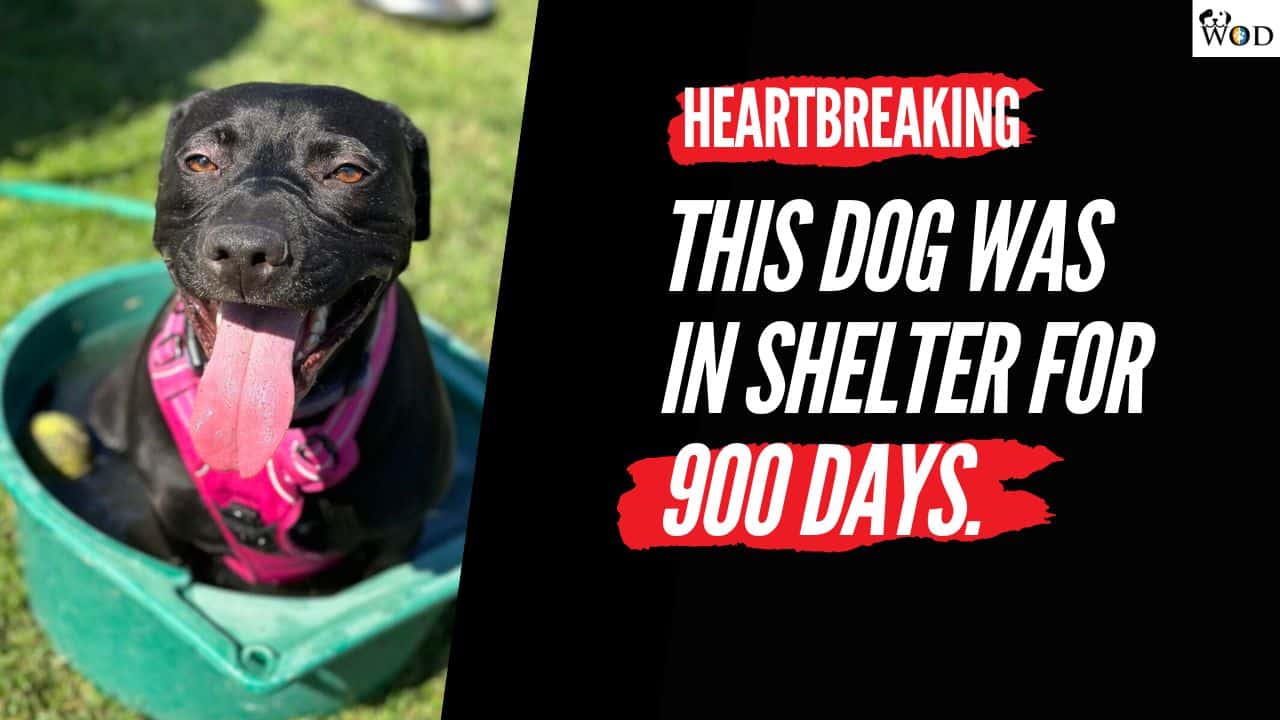As Poodle owners, we often ask ourselves, “What is the best diet for Poodles?” This question is crucial, as the right diet is key to our Poodles’ health and well-being. Poodles, from the petite Toy to the stately Standard, have specific nutritional needs.
The best diet for Poodles is a high-quality, protein-rich diet such as chicken, beef, duck, or fish. Grains, fruits, and vegetables, such as brown rice, pumpkin, apple, and carrots, are also nutritious. Furthermore, Poodles need fats, vitamins, minerals, and fiber to be healthy.
In this guide, we’ll explore the ideal types of dog foods, essential nutrients, and feeding guidelines tailored for Poodles. We’ll also highlight what foods to avoid, ensuring your Poodle enjoys a balanced, safe diet.
Whether you’re a seasoned or new Poodle parent, this guide will help you provide the best nutrition for your furry friend.
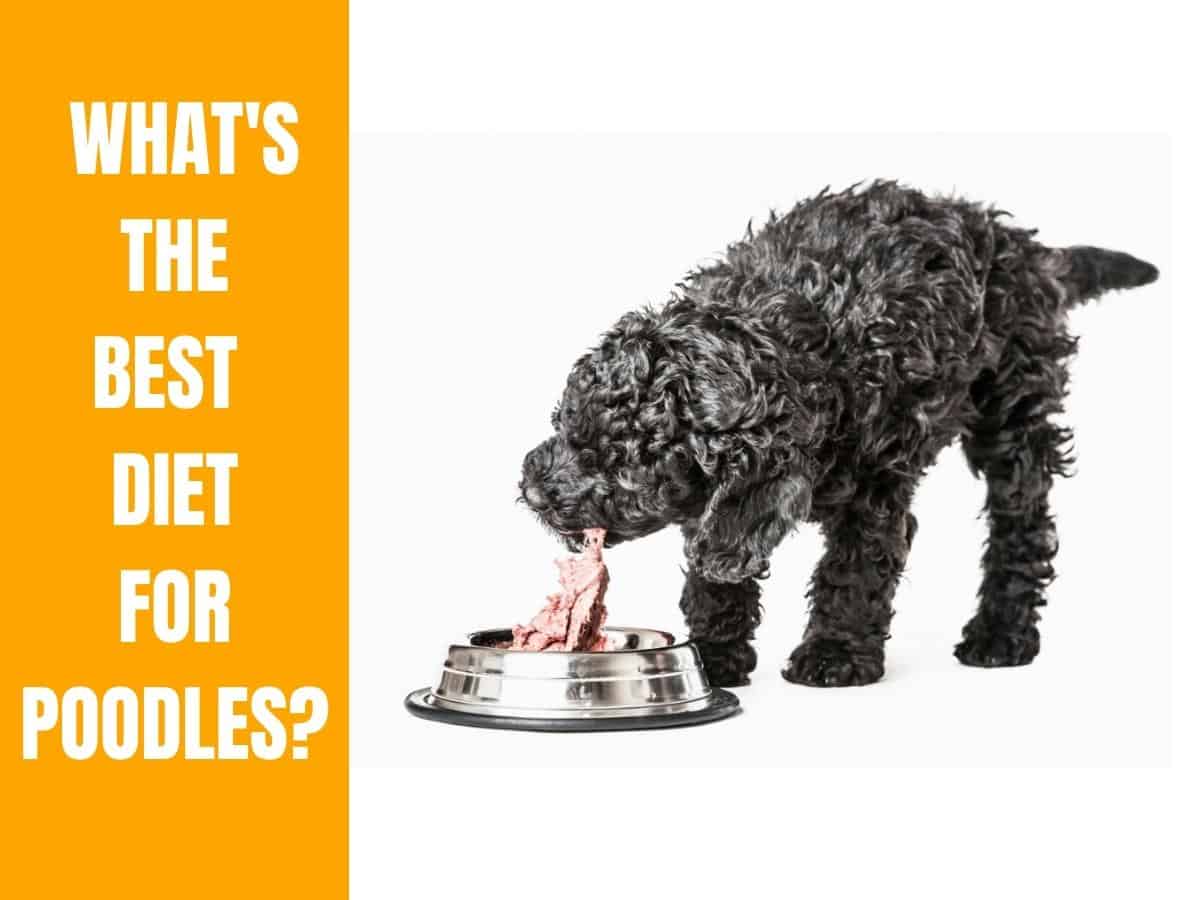
Nutrients for Poodles
Poodles are one of the more popular breeds globally and are known for their love of family, low-shedding curly coats, and intelligence.
Poodles require 22% protein during growth phases and a minimum of 18% protein as adults. Poodle puppies require 8% fat, while adults require 5%. Water, carbohydrates, vitamins, and minerals are also essential for survival.
Your Poodle’s nutritional needs are vital for keeping his essential body functions working perfectly and ensuring he is strong, healthy, and happy.
The MSD Vet Manual publishes dog nutritional requirements that detail all the vitamins and minerals that a Poodle’s diet requires. Let’s sum it up.
What is the Best Diet for Poodles?
What you feed a Toy or Miniature Poodle will differ from a Standard Poodle. To begin with, Toy Poodles weigh between 6-10 lbs, whereas the Standard variety may weigh up to 70 lbs, making their feeding routine and quantity of food completely different.
However, the principles of a Poodle diet are exactly the same.
Protein
When selecting what to feed your dog, choose foods with high-quality animal-based protein sources, such as beef, chicken, lamb, pork, eggs, and fish, and plant-based proteins, such as grains, legumes, and vegetables.
Protein is the essential nutrient in a Poodle’s diet and meal plan. Protein serves a variety of purposes:
- It gives your dog energy.
- Muscles are built and repaired.
- Forms new skin, hair, and nail cells.
- Maintains the health of the immunological and musculoskeletal systems.
Puppies and adult Poodles require varying amounts of protein. Adult dogs require an 18 % protein diet, while growing puppies require a minimum of 22 % protein.
Note: Protein is calculated on a dry matter basis when feeding commercial dog food, which indicates what’s left after the moisture has been removed from the food.
Fat
Fat is the second most important nutrient in a Poodle’s diet. Fat is derived from protein and serves as a source of energy. It’s also vital for the development and function of body cells, nerves, muscles, and tissues.
Essential fatty acids are necessary to keep your dog’s skin and coat healthy, and food fats improve the taste and texture of the dog’s food.
Similarly, the amount of fat required for puppies and adult Poodles differ. The advised fat content for growing puppies is 8% and 5% for an adult dog.
Vitamins
Poodles require vitamins in their food as vitamin deficiencies can cause various health problems.
- Vitamin A – Required for the proper function of skin, coat, muscles, and nerves and to reduce susceptibility to infections.
- Vitamin E – Dogs fed diets lacking vitamin E show signs of neurological problems, reproductive failure, and retinal degeneration.
- Vitamin B1 – A Thiamin deficiency can lead to weakness and neurological abnormalities. This study highlighted the role of thiamine in dogs and how a deficiency can be fatal if not reversed.
- Vitamin D – Some vitamins, such as vitamin D, play a significant role in extraskeletal health and are essential in small doses but toxic in high amounts.
Minerals
Minerals are also essential for your dog’s health, such as calcium and phosphorus, which are vital for strong bones and teeth.
Poodles also need sodium, magnesium, and potassium for nerve impulse transmission, cell signaling, and muscle movement.
Dogs can get too much or too little of a specific mineral in their diets.
For example, a calcium deficiency can cause secondary hyperparathyroidism, resulting in significant bone loss, skeletal abnormalities, and fractures. Poodle diets rich in natural meat alone can cause a calcium deficiency.
On the other hand, excess calcium can cause skeletal anomalies in growing puppies, especially those of large breeds, which is why the nutritional requirements of large breeds (which include the Standard Poodle) differ.
Large breeds should eat large-breed food.
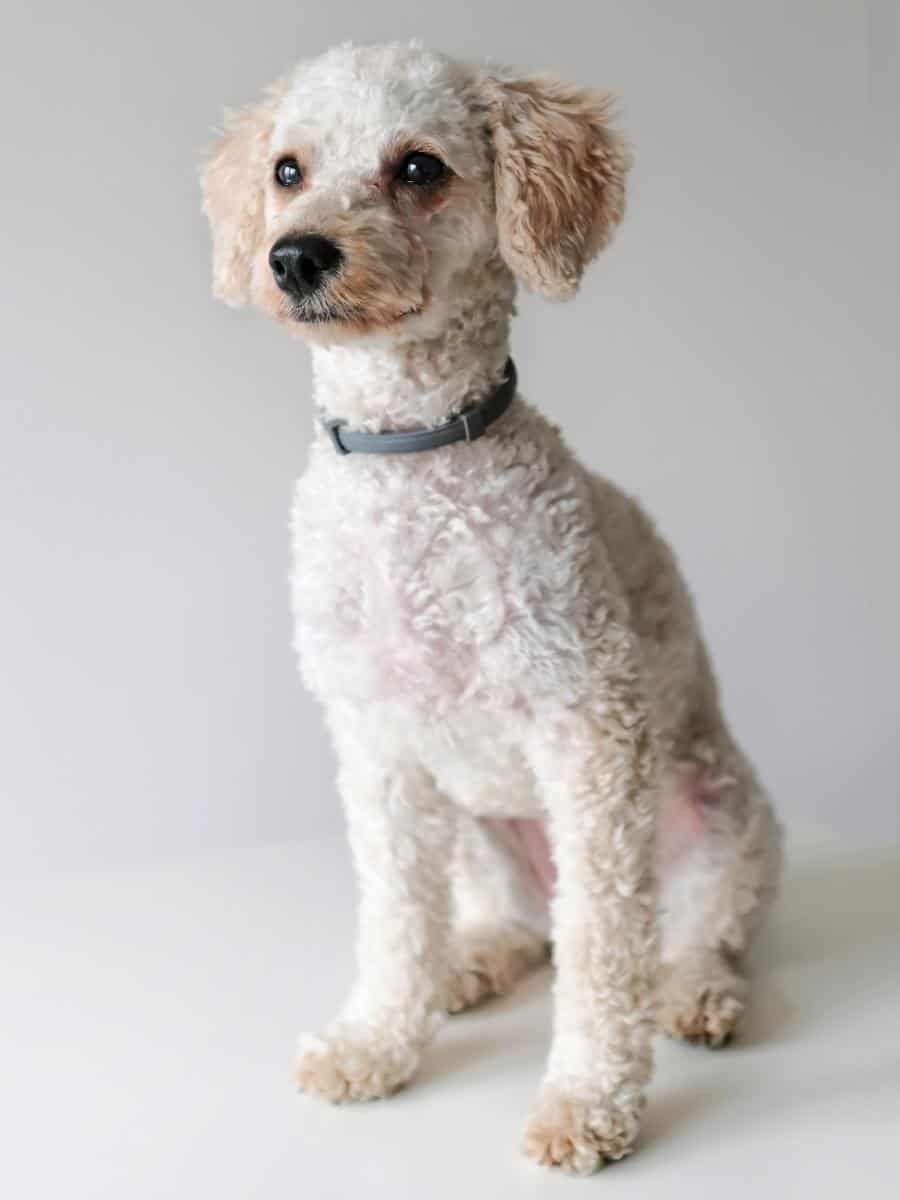
Water
Poodles should drink one ounce (30 ml) of water daily for each pound they weigh. Puppies will generally consume more despite their smaller size.
Age, size, exercise level, type of food eaten (dry or wet), weather, medication, and lactation are also factors.
Ensure your dog’s water bowl is always full and frequently changed throughout the day. Here are some fun methods to keep your dog hydrated:
- Give your Poodle ice cubes.
- Add water to dry food.
- Make doggie ice pops.
- Invest in a pet water fountain.
- In the summer, use a hose to have some fun.
Energy Needs
Your Poodle’s energy needs will vary according to age, size (Toy, Mini, or Standard), amount of exercise, and overall health.
Energy is measured in calories and originates from three vital nutritional components: protein, carbohydrates, and fats.
- A growing puppy needs twice the amount of calories as an adult.
- A dog that is pregnant or breastfeeding will require significantly more calories.
- A middle-aged Poodle may require 20% fewer calories in their diet than a senior dog.
For example, an active Standard Poodle will require a completely different diet than a Toy Poodle that likes to laze around all day.
How Much Food Should a Poodle Eat?
Your Poodle’s food needs largely depend on his size, activity level, age, metabolism, and overall health. The key is to ensure you don’t overfeed or underfeed your dog.
Average Daily Calories For Poodles
| Type of Dog | 8lb Toy Poodle | 15lb Mini Poodle | 70lb Standard Poodle |
|---|---|---|---|
| Puppy | 626 | – | – |
| Inactive Poodle | 237 | 337 | 1272 |
| Adult Active Poodle | 323 | 461 | 1740 |
| Senior Active Poodle | 262 | 372 | 1407 |
Looking at the above table, we can see that an active adult Standard Poodle weighing 70lbs needs 1740 calories daily, whereas an inactive Standard Poodle of similar weight only needs 1272 calories.
Follow the recommended feeding guidelines if you’re giving your Poodle commercial food. Most of the time, these are pretty accurate. However, here are some things to consider:
- Puppies need twice as many calories per pound of body weight as adult Poodles.
- Poodles who get minimal exercise may need 10% less than what’s advised on the food label.
- Active Poodles may need 20% to 40% more food.
- Make adjustments based on your dog’s health or body condition, as serious illness, pregnancy, or breastfeeding can increase energy needs.
- Working Poodles, such as hunting or service dogs, may need foods designed for working dogs as they have a higher fat content to provide extra calories.
There will be feeding instructions on the labeling of all commercial dog food. You can also use this handy dog calorie calculator, consult your veterinarian, or refer to the National Research Council’s science-based guide for your dog’s nutritional needs.
If you’re giving your Poodle homemade food, a daily serving size of 1 ounce of food per 1 pound of body weight is a good rule of thumb. As you may expect, depending on the particular ingredients used, this can vary quite a bit.
Pro Tip! Standard Poodles should be fed twice daily as it makes it easier to digest the food, control hunger, and prevent bloat (GDV), which can be life-threatening. However, Toy and Miniature Poodles may prefer three meals a day.
Pro Tip! When my puppy was young, I took her to the vet once a month to have her weighed and have her overall health checked.

What Can Poodles Eat?
So now that we know what nutrients Poodles require – let’s look at what they can eat. A balanced canine diet can consist of these foods.
| PROTEINS | GRAINS |
|---|---|
| Beef | Wheat |
| Chicken | Rice |
| Turkey | Oats |
| Venison | Oatmeal |
| Pork | Corn |
| Lamb | Maize |
| Duck | Rye |
| Liver | Quinoa |
| Kidney | Buckwheat |
| Heart | Barley |
| Fish | Teff |
| Salmon | Amaranth |
| Tuna | Millet |
| Mackeral | Spelt |
| Eggs | Bulgar |
| NUTS | DAIRY |
|---|---|
| Almonds | Cheese |
| Cashews | Cream |
| Peanuts | Ice-cream |
| Hazelnuts | Yogurt |
| Chestnuts | Milk |
| VEGETABLES | FRUITS |
|---|---|
| Artichoke | Apple |
| Asparagus | Apricot |
| Bell Peppers | Banana |
| Beets | Blackberries |
| Broccoli & Brussels Sprouts | Blueberries |
| Cabbage & Cauliflower | Coconut |
| Carrot | Cranberries |
| Celery | Cucumber |
| Corn | Dates |
| Cucumber | Kiwi Fruit |
| Eggplant | Mango |
| Green Beans & Peas | Melon |
| Lettuce & Kale | Nectarine |
| Parsnips | Peach & Plum |
| Pumpkin | Persimmon |
| Potato (cooked) | Olive |
| Rutabaga & Turnip | Pear |
| Spinach | Pineapple |
| Sweet Potato | Raspberries |
| Squash | Strawberries |
| Zucchini | Watermelon |
The following are some things to know:
- If fruits have pits or seeds, you should remove them because they contain cyanide, which is poisonous.
- You should cook most veggies to aid digestion.
- Although dogs can consume nuts, their high-fat content can cause gastrointestinal distress – and they pose a choking risk.
- Fruits, vegetables, dairy, and nuts should not exceed 10% of daily calories.
- Don’t feed raw eggs or raw seafood due to the risk of salmonella or listeria.
- Some dogs are lactose intolerant, preventing them from eating dairy foods.
While some types of human food are safe for your Poodle to eat, in general, it’s best not to feed your dog too many table scraps.
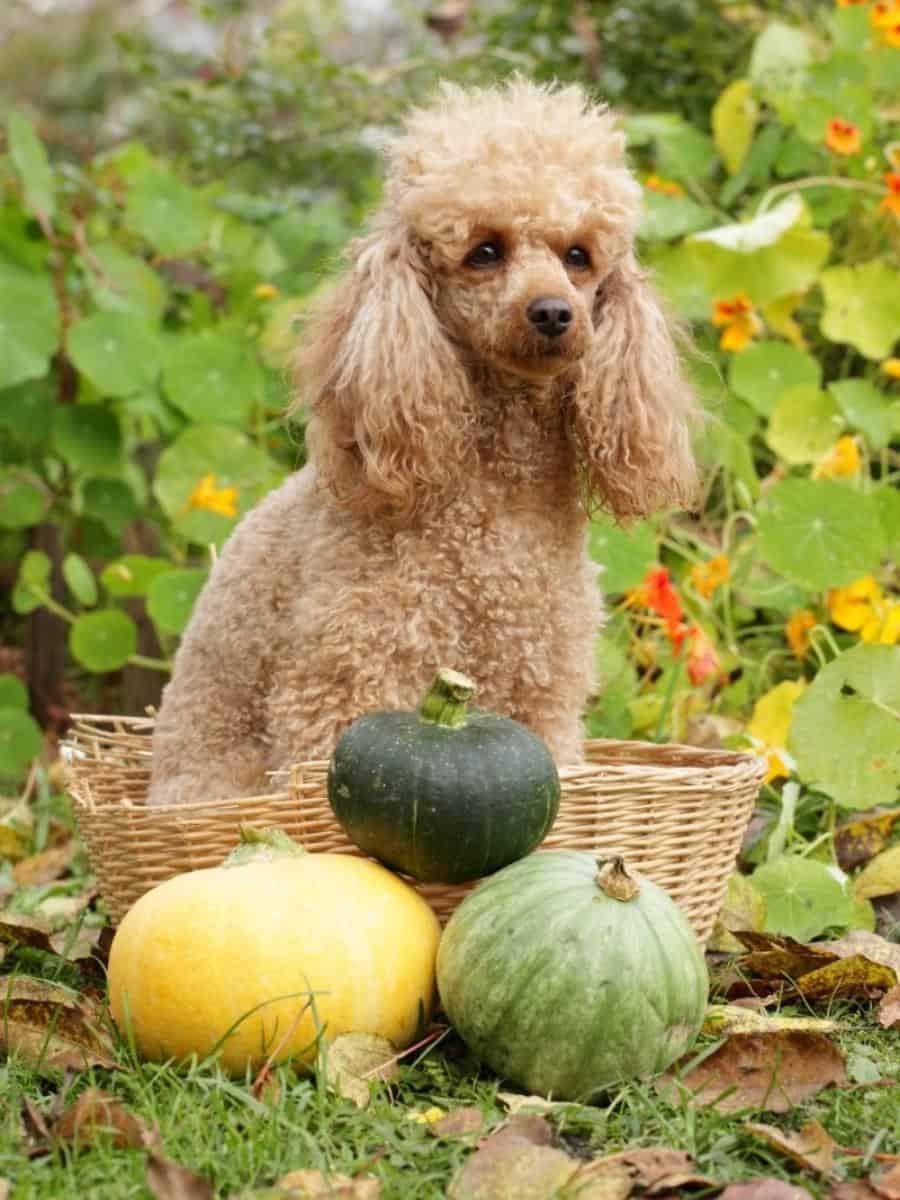
What Can Poodles Not Eat?
There are many foods that Poodles should not eat. I’ve listed the most toxic ones below:
| Alcohol | Avocado | Caffeine |
| Chocolate | Grapes | Garlic |
| Hops | Horse Chestnut | Macadamia Nuts |
| Mushrooms | Nutmeg | Onions |
| Leeks | Chives | Raisins |
| Rhubarb Leaves | Salt | Starfruit |
| Xylitol | Yeast Dough | Walnuts (Black) |
| Tomato (green) | Raw Potato | Shallots |
| Cocoa | Cherries | Moldy food |
The Pet Poison Helpline also has a comprehensive list of everything toxic to dogs, including plants, household goods, and medications.
Types of Dog Food
Many dog food companies have spent millions of dollars investigating which ingredients offer the highest quantities of nutrients to provide a healthy, balanced diet that promotes essential puppy growth and development.
The main types of diet that you can feed your Poodle are:
- Dry food
- Wet food
- A mix of dry and wet
- Home produced diet
- Raw diet
- Dehydrated
- Freeze-dried
You have to decide on the best type of dog food for your Poodle. It can be challenging to know where to start if you’re overwhelmed by all the choices, but it’s really not that complicated.
Let me help!
The best dog food for Poodles is dry food, as it’s convenient, cost-effective, and good for dental health. However, Mini and Toy Poodles may suit a wet diet, and if that’s the case, I’d mix the two for a good balance.
Poodles can also try other diets, such as homemade, raw, dehydrated, or freeze-dried.
In other words, dry, wet, or a combination are the most popular.
Understanding Dog Food Labels
The nutritional content of all commercial dog foods has to follow the guidelines developed by the AAFCO (Association of American Feed Control Officials).
Food must be ‘complete’ and ‘balanced.’ ‘Complete’ means “the food must contain all the nutrients required,” and ‘balanced’ means “the nutrients present must be in the correct ratios.”
The AAFCO also provides information on how to understand dog food labels. It’s a pretty heavy read, but it essentially means that manufacturers will nutritionally label dog food depending on the dog’s life stage.
These are:
- Gestation/lactation (pregnancy and nursing).
- Growth (includes puppies).
- Adult maintenance.
- All life stages.
A canine diet designed for all life stages meets the nutritional requirements for growth, reproduction, and adult maintenance.
This diet is, therefore, suitable for Poodles of any age. However, an “all life stage” diet is generally higher in calories, so only choose this diet if it fits your dog’s circumstances.
For example, if your Poodle is an adult, inactive, or needs to lose weight, you should choose a diet for adult maintenance. If your dog is a working dog or highly active, you may choose a diet for “all life stages” due to the extra calories.
When reading labels, keep in mind that what appears to be a large variation in the amount of a nutrient, for example, 9% protein in a canned dog food vs. 28% protein in a dry dog food, reflects the fact that the canned meal contains more water.
Check the packaging for what is known as “The Nutritional Adequacy Statement.” It was designed for vets, nutritionists, and dog owners to evaluate the food’s nutritional value.
This statement should say that the food meets nutrient profiles established by the AAFCO according to the dog’s life stage or passed feeding tests designed to AAFCO standards. It is the key to meeting all of your Poodle’s nutritional needs.
So, what’s the bottom line?
When choosing dog food, you should check the list of ingredients AND the nutritional content of the food.
Let’s now look at the popular types of dog food that should help you decide on the best diet for your Poodle.
In most cases, the diet of a Labradoodle is quite similar to that of a Poodle.
Dry (Kibble)
Dry dog foods are one of the most popular choices. There are two main types – KIBBLE and COLD-PRESSED.
The latter is gaining popularity in the United States and other regions and is already widespread in the UK and Europe.
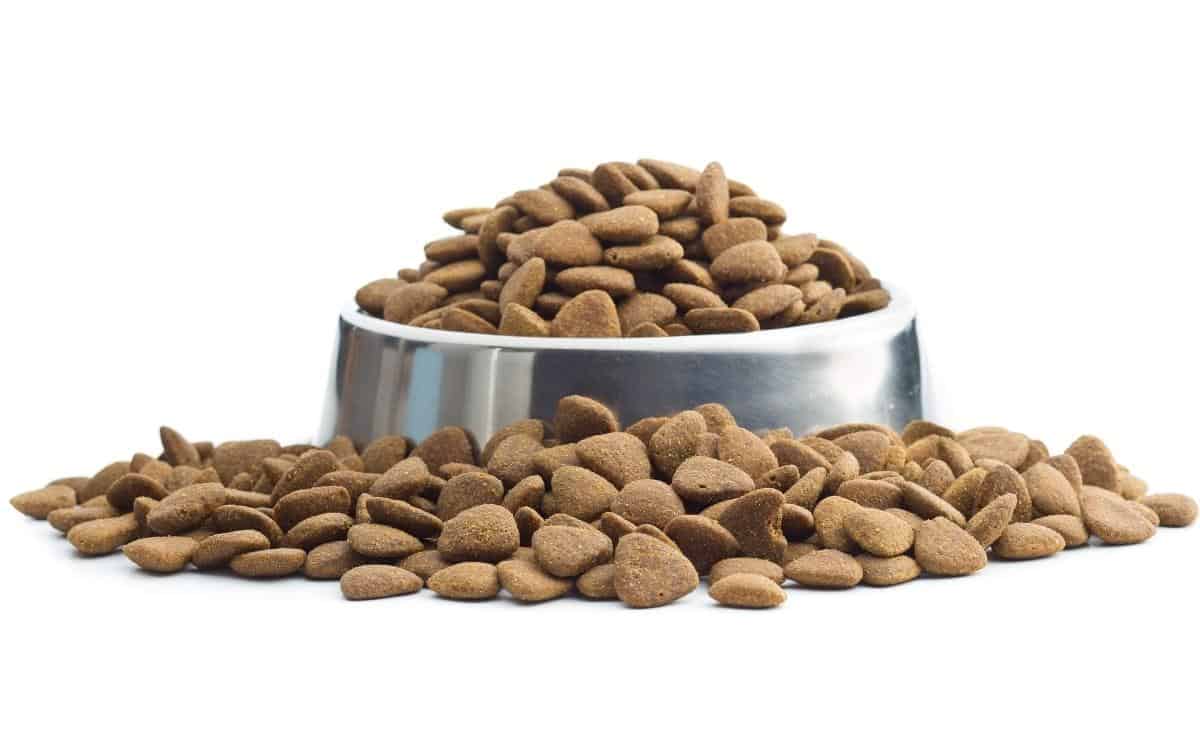
- Kibble – dry dog food made either through extrusion or oven baking. The food is produced under high pressure and high temperatures. All kibble is made the same way and using the same machinery. Even high-quality dry foods that use “human-grade” ingredients are made using the same process.
- Cold-pressed dog food – deemed a higher quality of kibble due to its cooking process. It’s produced at much lower temperatures and cooked quickly before being shaped. The food keeps more nutritional content, flavor, aroma, and vitamins due to this unique process.
Dry dog food is the most practical choice for a large dog, such as a Standard Poodle. However, dry food comes in all shapes and sizes, so a smaller-sized variety is perfect for a Miniature or Toy Poodle.
You can give dry food completely dry or soften it by adding water or unsalted broth. You can also add a topping such as chicken, beef, fish, veggies, or plain yogurt, and this is what I do.
I feed my dog cold-pressed dog food, and although this is a complete, balanced, high-quality food, I like to vary textures and flavors for my best friend.
My dog occasionally eats tinned tuna or mackerel on top of her food, which is also good for her skin and coat. If you do this, remember to slightly reduce the amount of dog food so your pup doesn’t gain any extra calories.
Wet (Canned)
Canned wet dog foods contain high moisture content – around 75%. There are a few things to keep in mind: not all canned dog food brands have the protein your Poodle needs, so choose wisely.
Lower-quality canned foods manufacturers often add wheat flour as a thickener or add extra white rice or other grains.
Also, the higher the water content, the fewer nutrients, so your dog has to consume more food to get the nutritional value their body needs.
Canned dog food can be more expensive, especially if you have a Standard Poodle, but it may be ideal if your dog enjoys eating a bigger portion.
Other advantages of wet food are that it may be more suitable if your Poodle is a fussy eater or if you have a senior dog who may have lost his appetite and may find wet food more palatable. You may also want to try wet food if your Poodle won’t eat.
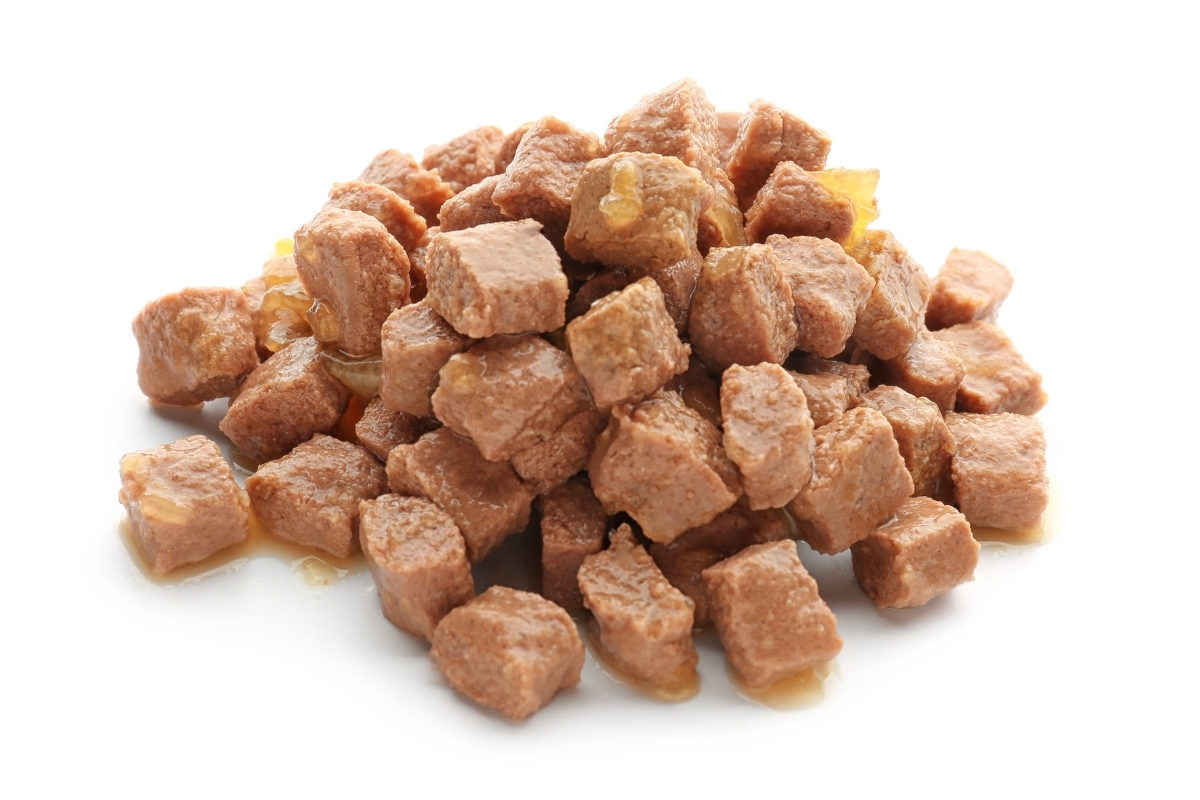
Semi-moist
Semi-moist dog foods are not as common as other types as they offer the least nutritional value and are pretty expensive.
Unfortunately, sugar and salts are added by manufacturers to preserve moisture and shelf life. As a result, a semi-moist diet may not suit your dog, especially if he is overweight.
Many semi-moist foods are also loaded with artificial colors, chemical preservatives, and flavor enhancers.
However, a semi-moist diet may be the best choice if your Poodle finds it challenging to digest all other dog food. Your pooch may also enjoy the meaty taste and find the food more palatable if he’s incredibly picky.
Dry Dog Food vs. Wet Dog Food
Dry food is less expensive per serving than canned wet food, and it can result in less waste because it can be left in your dog’s feeding dish for longer.
Dry food also benefits dogs with dental problems because it helps clean their teeth and gums. Numerous studies have found that kibble can reduce plaque. This study even found that pellet food size prevents calculus accumulation.
Dry dog food provides more nutrients per bite than wet food because it contains less moisture, which means you can feed less to satisfy your Poodle’s appetite and nutritional needs.
| Dry Dog Food | Wet Dog Food |
|---|---|
| More practicable for large dogs | More practicable for a toy or small breeds |
| Inexpensive and less waste | More expensive than dry foods |
| Provides more nutrients per bite than wet | Good for picky and senior dogs |
| Convenient and easy to feed | Good for hydration if your dog doesn’t drink much |
| No need to refrigerate | There can be more waste if the food is uneaten |
| Good for “grazers” as it can be left in the bowl longer | Good for dogs who have trouble chewing |
| Can add cooked meats, fish, or veg | It has a longer shelf life than dry |
| Can add water to make a tasty gravy | Dogs can enjoy a larger portion per meal due to the high water content |
| Available in many shapes and sizes | Some dogs find wet more palatable than dry foods |
| Great for interactive feeders | Watch out for added salt and sugar in semi-moist |
| It can be good for the teeth | May contribute to gum disease |
A Mix of Dry and Wet
A third alternative is to mix dry and wet foods. For example, you can give dry food in the morning and wet in the afternoon or combine the foods in the same bowl. Stick to the same brand if choosing this option.
If you mix dry and wet, you’ll need to make sure you’re not increasing your dog’s calories, and you may need to get advice from your veterinarian to ensure you’re supplying the proper nutrition.
| Pros of a Mix Diet | Cons of a Mix Diet |
|---|---|
| You get the best of both dry and wet | Need to track calorie intake |
| Can mix in the same bowl or at separate feeds | May require your vet’s advice |
| Provides variety | Should keep to the same brand |
Home Produced Diet
Some owners choose to feed their Poodles a home-produced diet. Here are some reasons why you might choose to be a home feeder:
- You have concerns about the nutritional value of the ingredients used.
- You enjoy preparing the food to increase the bond with your dog or satisfy your views.
- You believe that your pet will not like or refuse commercial dog food.
- Your dog may need a home-prepared diet to assist with a diagnosis (e.g., for a food elimination trial).
- If your dog has various diseases for which no commercial diet exists.
- If you seek comfort as a home feeder if your dog has a chronic or terminal illness.
There are various disadvantages to making dog food at home. You can do it, but it will take a lot of effort and hard work, and it may cost more than even the highest-quality dog food available.
Diets prepared at home can give complete nourishment. However, it is difficult to ensure that your Poodle receives the proper balance of protein, fats, carbohydrates, minerals, and vitamins.
I’d advise you to consult your vet or a pet nutritionist certified by the American College of Veterinary Nutrition who have the expertise to customize a healthy diet for your pet. Here’s their directory.
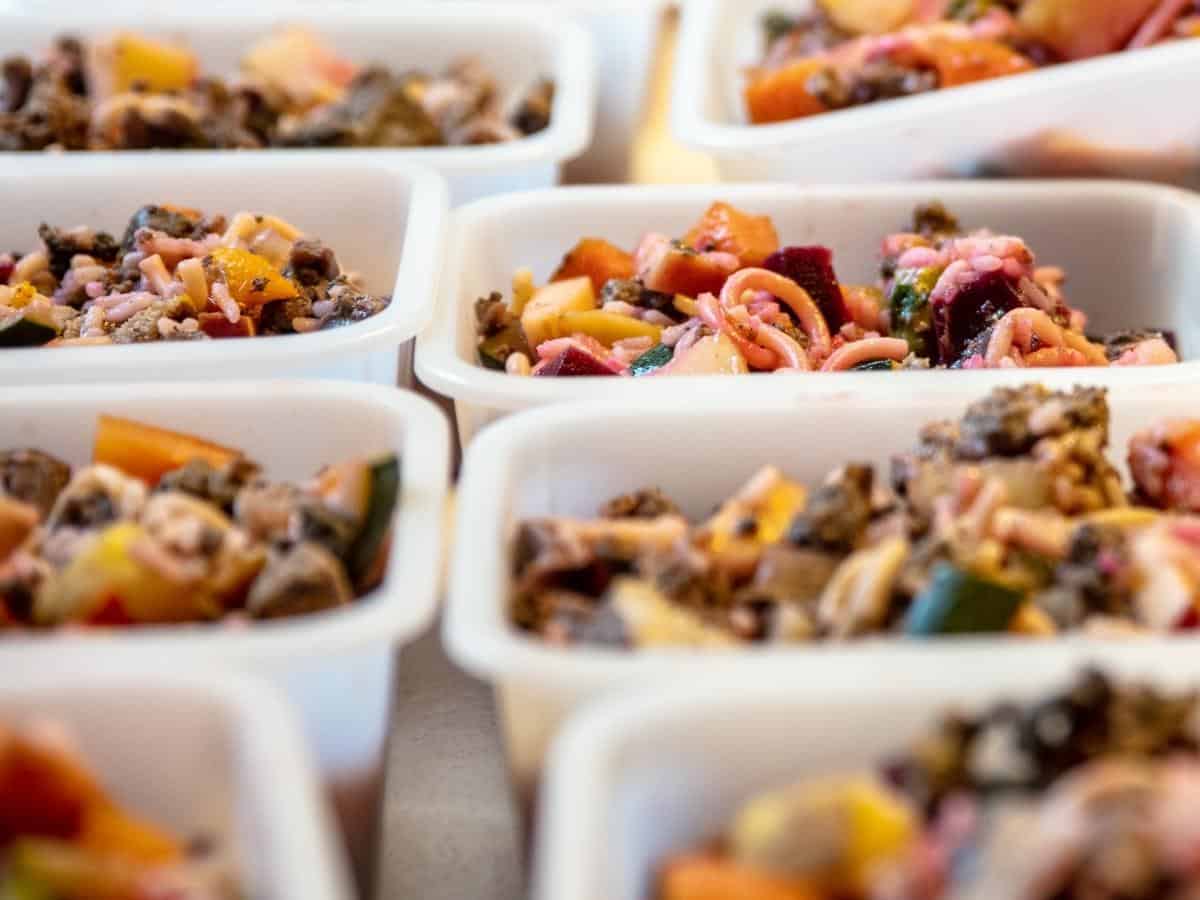
You should cook all animal products to kill bacteria that could make your pooch sick. You should also cook grains and starchy vegetables for easier digestion.
My thoughts on whether to become a home feeder:
- Do you have the time to prepare the meal?
- There are some top-quality dog foods nowadays.
- Your dog will need regular health checks for any nutrient deficiencies.
| Cons of Home-Produced Diet | Cons of Home-Produced Diet |
|---|---|
| You are in control of your dog’s food | Regular health checks are advised to ensure correct nutrition |
| It may suit picky eaters | Expensive |
| Can assist with a medical diagnosis or healing | Time-consuming |
Raw Diet
Occasionally, there will be a trend for feeding dogs an all-raw diet. Although it’s safe to feed a puppy raw food after three to four weeks, it’s essential to ensure that your Poodle gets all the nutrients they need and isn’t at risk of poor health or disease.
When determining whether or not to feed your dog raw food, you should consider two things. The main worry with raw feeding is ensuring you provide your dog with a well-balanced meal, especially for developing pups.
It can be hard not to under or overfeed essential nutrients, so consult your vet or a nutritionist before feeding raw.
Formulating a raw diet can also be challenging if your Poodle is pregnant, breastfeeding, or sick, as they’ll have different nutritional requirements.
Food safety issues, including bacterial or parasite contamination, are the second most pressing concern. Don’t overlook the health risks of feeding raw foods to your pet, so ensure you follow the guidelines for the safe and proper handling of raw foods.
Many raw-feeders claim that feeding your dog a raw diet has many health benefits, from better digestion, a shinier coat, healthier skin, and stronger teeth to less disease and generally living a longer and healthier life.
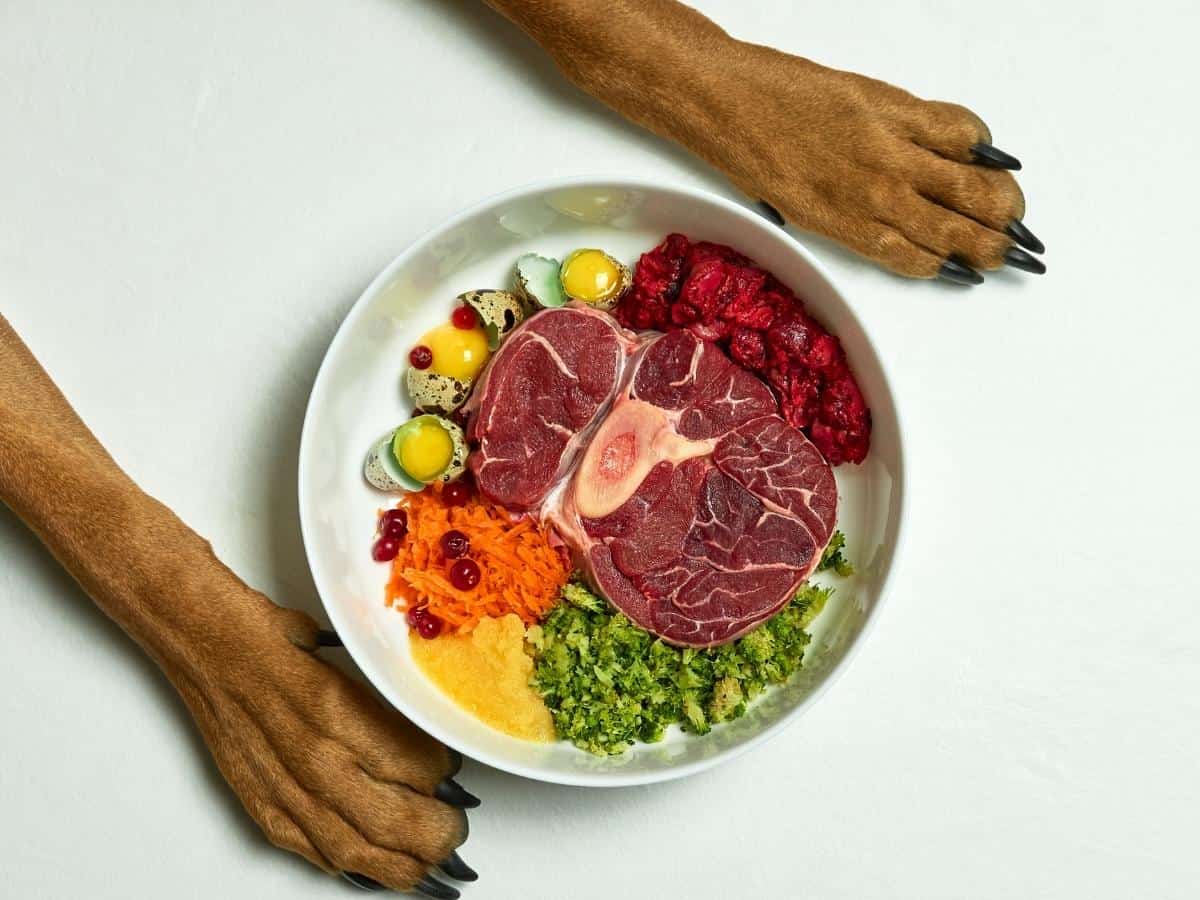
However, according to the ACVN (American College of Veterinary Nutrition), most of the believed benefits of feeding raw foods remain unproven due to insufficient research.
They say, “no studies have examined differences in animals fed raw animal products to those fed any other type of diet (kibble, canned, or home-cooked) with the exception of looking at the effects on digestibility.”
If you decide to feed your Poodle a raw diet, you may prepare the food yourself or buy commercial raw food products. These include everything from frozen or freeze-dried whole diets to grain and supplement mixes combined with raw foods.
| Pros of Raw Diet | Cons of Raw Diet |
|---|---|
| You control your dog’s food and nutrients | Need to ensure proper nutrition |
| Aids better digestion | May be unsuitable for sick or senior dogs |
| Firmer stools | Risk of food contamination |
| Cleaner teeth and fresh breath | No proven health benefits & health checks advised |
Dehydrated and Freeze-Dried
You can choose to feed your Poodle a dehydrated or freeze-dried diet, which has become increasingly common in recent years. They are similar in one sense, as they extract moisture from the food to preserve it, but they vary in several ways.
Dehydrated Foods
Dehydrated foods are partially cooked at low temperatures to extract most of the water. The food is heated but not fully cooked, so nutrients and enzymes remain complete. Owners see them as a step up from extruded kibble.
To make dehydrated dog food edible, mix it with warm water. The food has a texture similar to canned wet food, but it is far less processed. It is easy to store and prepare and has a long shelf life because the food does not need refrigeration.
If your Poodle has a sensitive stomach, a dehydrated diet is an excellent option because the food is easier on the digestive system due to the gentle heating procedure.
Freeze-dried
Freeze-dried foods are essentially a repackaged raw diet. The raw ingredients are frozen first and placed in a vacuum to transform the moisture into vapor.
The food is then sealed in an airtight container. This method (unlike a raw diet) minimizes the number of bacteria like salmonella.
Although freeze-dried food appears like kibble and does not require rehydration before consumption, adding water will make it more appealing and digestible for your Poodle.
Freeze-dried foods are high-protein diets with fruits and vegetables occasionally added.
This diet is an excellent alternative if you want to feed a raw diet but don’t like to handle raw food but want to provide a healthier and less processed diet.
Freeze-dried foods are more expensive than regular kibble, but as the food has most of the moisture removed, it is more nutritionally dense, so you feed your Poodle less.
| Pros of Dehydrated & Freeze-Dried | Cons of Dehydrated & Freeze-Dried |
|---|---|
| Nutrients remain intact | Very expensive |
| No added preservatives | May still contain bacteria |
| Convenient, easy to store, long shelf life | Might be hard to source |
Learn More About The Different Dog Food Types In This Video…
Poodle Puppy Diet and Meal Plan
A growing puppy has different nutritional needs than an adult dog, and pups need feeding more frequently at various stages of growth. So, how often should you feed a Poodle puppy?
Poodle puppies should be fed 4 meals a day up to 3 months of age, 3 meals a day up to 6 months of age, and 2 meals a day from 6 months up to adulthood.
| Age of Poodle | Daily Meals |
| 6 to 12 weeks | 4 |
| 12 to 24 weeks | 3 |
| 24 weeks onwards | 2 |
Growing Poodle puppies need to take in enough calories, fat, protein, vitamins, minerals, and water to meet the rapid growth that will set them on the right path to a healthy life.
They should continue on a puppy diet until adulthood – up to 24 months in Standard Poodles, 18 months in Mini Poodles, and 12 months in Toy Poodles.
However, you may choose to switch your Standard Poodle to an adult diet after six months to help prevent too-rapid growth, leading to joint issues such as hip dysplasia in large breeds.
Many puppy foods explicitly labeled for large breeds are formulated to address these issues.
At two months, I switched my pup from puppy food to adult food. However, as I fed her high-quality food, this was fine. When transitioning food to an alternative type or brand, plan to switch over a week gradually.
Most dog foods will give detailed instructions on the packaging but essentially start with 75% of the old food and 25% of the new and taper down to 100% of the new food throughout the week.
Bones for Poodles
Bones are a good source of nutrients for your Poodle, especially calcium, magnesium, and phosphorus, and help keep teeth clean and strong.
However, don’t give your Poodle a cooked bone to chew, as the bone will soften and can splinter in the mouth, causing injuries or choking.
Choose a sizeable raw bone larger than your dog’s muzzle so he won’t be tempted to swallow it. Beef or lamb bones are better than chicken or pork bones as they are stronger and won’t easily splinter.
For example, a large beef shank bone would be just the thing for your Standard Poodle, whereas Mini and Toy Poodles are best suited to smaller lamb bones.
Treats for Poodles
Ensure dog treats don’t exceed 10% of your Poodle’s daily calories. Ensure you buy good quality treats, as many provide little nutritional value and don’t have to follow AAFCO standards.
Treats should be low in fat and calories and free of additives, chemicals, and coloring. Of course, you can use alternatives such as fruit and veggies or small pieces of meat.
Final Thoughts
To wrap up, the secret to a thriving Poodle is a nutritious, high-quality diet that matches their life stage and fits your lifestyle. Opt for a diet rich in proteins, balanced with grains, fruits, and vegetables, and fortified with essential nutrients.
Investing in the best dog food you can afford goes a long way in ensuring your Poodle’s health and longevity. Ultimately, the right diet is a cornerstone of your Poodle’s well-being and a testament to your care and commitment.
Related Posts You May Like:





